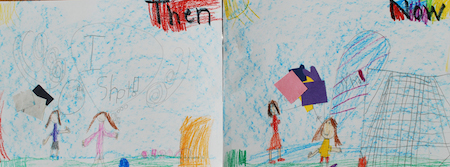by Prisca Martens, Towson University
 This month in WOW Currents we’re exploring how to help children read the art and written texts in picturebooks, Picturebooks are “a unique art object, a combination of image and idea that allows the reader to come away with more than the sum of the parts” (Kiefer, 1995, p. 6). In our work we’re helping children read the art and think like artists to support them in experiencing the full richness and meanings in picturebooks (Martens, 2012). This week we’ll explore how Laura Fuhrman helped her first graders read and experience the art and written text in Sebastian’s Roller Skates, written by Joan de Deu Prats (2005) and illustrated by Francesc Rovira.
This month in WOW Currents we’re exploring how to help children read the art and written texts in picturebooks, Picturebooks are “a unique art object, a combination of image and idea that allows the reader to come away with more than the sum of the parts” (Kiefer, 1995, p. 6). In our work we’re helping children read the art and think like artists to support them in experiencing the full richness and meanings in picturebooks (Martens, 2012). This week we’ll explore how Laura Fuhrman helped her first graders read and experience the art and written text in Sebastian’s Roller Skates, written by Joan de Deu Prats (2005) and illustrated by Francesc Rovira.
In the story Sebastian is a shy boy who doesn’t speak much, even though he has a lot to say. One day he finds a pair of roller skates in the park and decides to try them on. He falls down but over the next several days, he continues to try to skate until he is successful. Sebastian uses the courage he gained from learning to skate to confidently share his thoughts with those around him, including Ester in his class who he liked but was too shy to speak to before. Rovira’s art beautifully shows Sebastian’s growing confidence. On the beginning pages, when Sebastian is shy, the large thought/feeling bubbles are created in black and white with newspaper. Once he gains confidence, Sebastian’s speech bubbles are in bright colors as he shares all he has to say. Before reading, Laura first asked her first grades what they noticed about the cover. Children immediately noticed the newspaper pieces and how they stretched towards Sebastian. Some commented that maybe the newspaper represented a ghost or a monster or a tree trying to grab Sebastian. Laura asked the children to look at the newspaper on the pages as she read and see if they could figure out why the artist Francesc Rovira used them. When she started reading, the children quickly figured out the newspaper represented Sebastian’s thoughts and that they were in black and white because he was feeling shy and didn’t want to speak. As she continued, the children equated the bright colors with Sebastian’s confidence in himself, his happiness that he could skate, and all the ideas he finally shares with those around him. Their favorite page was the one filled with orange, red, and purple hearts as Sebastian speaks to Ester.
After reading, Laura showed the children various art materials, including newspaper and different colored paper. She asked the children to think of something they cannot do “now” but hope to do in the future (“then”), consider what their speaking/feeling bubbles would like in each of those instances, and create pictures for them, similar to Rovira’s, and write about them.
Jack’s art revealed his desire to learn how to drive. In his “Now” picture, he is on the left holding the remote control for his car and has newspaper for his thought bubble. For this picture he wrote, “Now I can play with my remote control car.” Jack’s “Then” picture shows him with a colored-paper thought bubble reflecting his joy, driving a race car and someone in the control booth next to the score board. For this picture he wrote, “When I grow up I will drive a race car.”

Laura also gave the children the option of creating their pictures about something they could not do when they were younger (“then”) but can do “now”. Marcia made her “Then” picture about when she could not score a soccer goal by herself. She drew herself (in purple) with the black and white thought/feeling bubble saying, “Good luck with that” to her teammate (in pink) who is saying, “I shot!” For this picture Marcia wrote, “Then I could not shoot a goal in soccer. I needed other teammates to help me.” In her “Now” picture Marcia (in yellow) has a brightly colored thought/feeling bubble to show she is happy she scored. She also used bright colors as background for “Now” in the upper right corner and for her speech bubble which shows her saying, “Yeah!” For this picture Marcia wrote, “Now I can shoot a goal by myself!”
Through this and similar experiences with other picturebooks, Laura is helping her students understand that art is a system through which they can represent and communicate meanings.
References
de Deu Prats, J. (2005). Sebastian’s roller skates. Illus. F. Rovira. La Jolla, CA: Kane/Miller.
Kiefer, B. (1995). The potential of picture books: From visual literacy to aesthetic understanding. Englewood Cliffs, NJ: Merrill.
Martens, P., Martens, R., Doyle, M., Loomis, J., & Aghalarov, S. (2012) Reading picturebooks multimodally in first grade. The Reading Teacher, 66(4), 285-294.
Please visit wowlit.org to browse or search our growing database of books, to read one of our two on-line journals, or to learn more about our mission.
- Themes: Prisca Martens
- Descriptors: Student Connections, WOW Currents

